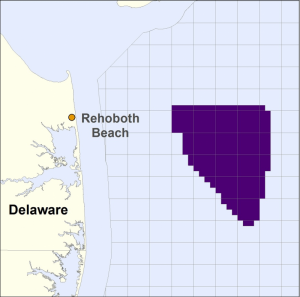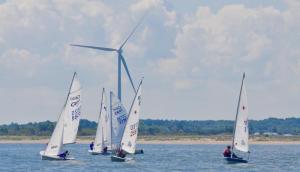Offshore wind back on Delaware's horizon
Delaware is revisiting the potential of offshore wind energy.
Gov. John Carney signed an executive order Aug. 28 establishing a 17-member working group to explore environmental and economic benefits of offshore wind turbines on the First State's coast.
“We must look for ways to participate in the development of alternative energy sources,” said the governor, who also has been outspoken in his disapproval of offshore drilling for oil and gas.
The Offshore Wind Working Group will begin meeting this month, and is expected to deliver a report on its findings by Friday, Dec. 15. That report will outline strategies for the development of wind power and propose draft legislation.
University of Delaware professor Jeremy Firestone, who has been studying wind energy since 2003 and will serve as a member of the working group, said the group will examine the costs and environmental benefits, projections of what ratepayers can expect from wind energy, and legislation to support the alternate energy source.
“We've surveyed the public many times, and they're supportive of offshore wind,” Firestone said. “They hunger for an energy transformation.”
It's been nearly a decade since Delaware last considered using wind energy to power its grid. Firestone said Delaware imports its power, most of which comes from fossil fuel and nuclear sources.
Back in 2007, Bluewater Wind was one of three bidders seeking to provide wind-generated power to the First State through a Public Service Commission-approved power-purchase agreement with Delmarva Power. Delaware was poised to be the nation's offshore wind pioneer, Firestone said.
But the Great Recession hit Bluewater Wind's parent company hard. Soon after, NRG Energy, which owns and operates the coal-fired Indian River power plant, bought Bluewater Wind.
The inability to secure low-interest loans and a lack of movement on wind-friendly federal policies eventually forced NRG Bluewater Wind to abandon plans to build a wind farm off Delaware's coast. The company had leased 96,400 offshore acres from the federal government to build a 120-turbine wind farm off the coast of Rehoboth Beach. The company sold that lease in 2016.
Deepwater Wind, which recently built the nation's first commercial offshore wind farm off Rhode Island, now plans to construct Skipjack Wind Farm, a 15-turbine wind farm off Delaware's coast that will generate electricity for Maryland's power grid in that leased area. At the same time, U.S. Wind Inc. is planning a 62-turbine wind farm at another location about 12 miles off the coast of Ocean City.
“From a timing perspective, if they're already planning on building some wind turbines in those areas, there's an opportunity for Delaware – if it acts – to do something in conjunction,” Firestone said.
Jobs, economic growth potential
Sen. Tom Carper, who attended the executive order signing, said investing in new offshore wind projects spurs economic growth and has the potential to create good-paying jobs.
Clint Plummer, Deepwater vice president of development, said the stretch from Boston to Washington, D.C., is the biggest area of energy consumption in the United States, with the oldest fleet of energy-providing facilities. There are growing needs for new power sources in these highly populated areas along the coast, and Delaware is in a vital part of the corridor, he said.
Plummer said wind power-produced energy is a $20 billion industry globally. There are 85,000 jobs in Europe right now associated with the production of wind power.
Yet to come to fruition, the two projects benefiting Maryland’s economy could be seen as examples.
As part of the award announcement in May, the Maryland Public Service Commission attached nearly 30 conditions to the approval, including requirements that the developers create a minimum of nearly 5,000 direct jobs during the development, construction and operating phases of the projects; pass 80 percent of any construction costs savings to ratepayers; and contribute $6 million each to the Maryland Offshore Wind Business Development Fund.
The companies will be required to use port facilities in the greater Baltimore region and Ocean City for construction, and operations and maintenance activities. The developers must invest collectively at least $76 million in a steel fabrication plant in Maryland and together fund at least $39.6 million to support port upgrades at the Tradepoint Atlantic (formerly Sparrows Point) shipyard in Baltimore County.
Plummer said the Skipjack project is expected to produce 120 megawatts of power, which, he said, is enough to power 35,000 homes. He said Deepwater’s lease is for 96,000 acres and has a total production power of 800 megawatts.
“The plan is to develop that area with multiple projects,” he said, adding the company’s focus right now is getting Skipjack up and running. “The way these very first projects go is going to set expectations. It’s important to get them right.”
Offshore wind projects would be bigger, better
Producing wind-generated energy on a commercial scale would mean constructing turbines much larger than the single land-based turbine in Lewes, Firestone said.
“They will be bigger,” Firestone explained, adding that compared with older designs, a new offshore wind farm would have fewer turbines spread farther apart because of the sheer size of the equipment.
Newer turbines produce up to 9.5 megawatts, with rotor diameters twice the size, at nearly 600 feet, he said.
The increase in size has been driven by economics, he said. With bigger blades sweeping a larger area, turbines can catch a lot more wind power and become more economical, he said. There’s also more wind the higher the blades reach, so more power can be generated.
With more experience installing wind turbines, new information on siting the technology, and increasing lender confidence, the cost of harnessing wind energy will continue to drop, Firestone said.
“The costs have come down much faster than anyone imagined,” he said.
Firestone said any future offshore wind farms along Delaware would likely be in line with the pending Delmarva projects. U.S. Wind expects to build a farm off Ocean City in 2020, while the Deepwater Wind project off Rehoboth Beach is expected to come online in 2022.
“I think there's a good opportunity for Delaware,” Firestone said. “The time is right.”
Lewes turbine supports key research
By Maddy Lauria
Local researchers have sought to solidify the science behind offshore wind development along Delaware's coast.
In 2010, the First State's sole commercial-sized wind turbine came online in Sussex County. The 2-megawatt turbine now generates enough power annually to provide electricity to six buildings at the University of Delaware's campus in Lewes, as well as more than 100 homes.
The turbine has offered professors and students a way to research such topics as turbine impacts on avian species, public perception of wind energy, how offshore wind turbines might impact hurricane winds, and the corrosive effects of saltwater on the equipment.
The avian study found bats were more susceptible than birds to death or injury by the 140-foot-long rotating blades. That prompted operators to install a “bat shield,” technology that avoids rotation during peak migration and travel times.
“We've learned about avian interaction, so I think people will be a little less concerned than otherwise,” UD professor Jeremy Firestone said.
A survey sent to more than 450 coastal residents in 2012-13 found most respondents supported the land-based turbine, largely because it represented progress toward clean energy. About 10 percent of respondents said they had a negative view of the turbine.
Since 2009, the U.S. Department of Energy also has invested nearly $7 million in six offshore wind energy studies related to Delaware, four of which were conducted by the University of Delaware. Those projects looked at the concentration of wildlife along the mid-Atlantic continental shelf, an experimental pivot turbine that could potentially reduce construction costs, legislation and outreach, interconnection and transmission, and system design for an offshore wind farm near the Wilmington Canyon.
Gov. John Carney's working group will not be exploring the technical feasibility of wind power, Firestone said. That area has been heavily researched in the First State and throughout the world.




























































